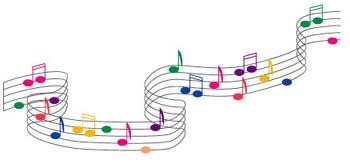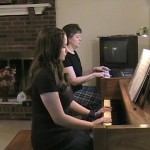The Church Pianist: Upcoming Article (Free Piano Arrangement)
April 28th, 2010I’ll be posting a free piano arrangement of “Like a River Glorious” sometime this week. This free arrangement will be written in a prelude/congregational style for the church pianist.
“Like a River Glorious” is a beautiful hymn….speaking of God’s wonderful, everlasting peace that He gives to those who have trusted in Him.
The Church Pianist: Scales in Hymns (Part Four)
April 23rd, 2010To start with…I will show you a page of hymn arrangement samples containing scales. Scales are used to embellish a melody or simply as a fill-in. In the following examples…both functions are utlizied.
Editor notes for Scale Variations in Hymns
Count Your Blessings (the opening scale is added as extra filler to an introduction)
Jesus Loves Me (the scale creates a nice dress-up for the melody)
Let the Lower Lights Be Burning (this scale creates a nice filler on the syllable “more” and blends into the next two words “But to”)
Editor Notes for final page “Practical Scale Exercises”
When trying to master technical passages in hymn arrangements…I will isolate the passage and master it. Sometimes I create or embellish upon the passage making it more fun to practice. Hope the following scale exercises will stimulate other church pianist’s creativity.
The Church Pianist: Upcoming Article on Scales
April 22nd, 2010I hope the previous articles on scales in hymns has been a help to many church pianists. Scales add so much life to hymns, don’t they?
Tomorrow’s final article on scales will feature some different ways to play scales…preparing the church pianist for real-life application of scales to hymns. You may find it interesting to know where I get my ideas for scale drills. 🙂
The Church Pianist: Scales in Hymns…Part Three
April 16th, 2010Scales add life to hymns!
I’ll show you one way to insert a scale in the first measure of a hymn or in some cases…adding an extra measure to make the scale fit at the beginning.
Editor notes for today’s… Scale Examples in Hymns
1. The scale in each example equals two counts.
2. This type of scale entry works well when the first note of the song begins on the 5th note of the present key.
It is Well is in the key of C and the first note is “G” which is the 5th note of the C scale
3. Notice…the scale in each example begins one octave (8 notes) lower than the first note of the song.
4. When the first word of the song occurs in an incomplete measure…(as in “It is Well” and “He Hideth My Soul”)…the first word will be understood during the scale. Reminds me of English…when “you” is understood in the sentence even though it may not be written 🙂
Application:
Try this scale idea in other hymns of similar design!
The Church Pianist: Free Piano Hymn Arrangement
April 15th, 2010This free piano hymn arrangement of “I Feel Like Travelling On” is geared for the beginning church pianist at an early elementary level.
My piano student featured in this video, is a church pianist who plays by ear but is learning to read music. She’s doing quite well! I’m writing arrangements with her level in mind.
Maybe some of you church pianists can share this with your students or use this free piano hymn arrangement for yourself.
I haven’t forgotten part three of Scales in Hymns 🙂 I will post it tomorrow.
Scales in Hymns (Part Three)… Upcoming Article
April 14th, 2010I plan to post part three of scales in hymns by the end of this week.
Some church pianists may not understand where to insert a scale in a hymn.
Scales can be placed in several different places in a hymn. The upcoming article will show the church pianist how to add a scale to the very first measure of a hymn!
Looking forward to sharing the examples with you!
The Church Pianist: Beginning Church Pianist (Congregational singing)
April 7th, 2010For the past several months, I have been training one of my students to be a church pianist. Letha will get her first opportunity to play for congregational singing this Sunday. (Our church has two pianos in the auditorium.)
I’m excited for her! I thought I would share us practicing one of the congregational piano arrangements entitled “Higher Ground“.
The Church Pianist: The Importance of Scales (part two)
April 5th, 2010Believe it or not…scales are very important to the church pianist!
Click on the following titles to see examples of scale passages in hymn arrangements:
Blessed Assurance (two octave scale) arr. by Marilynn Ham
A Child of the King (one octave scale) arr. by Marilynn Ham
Count Your Blessings (mainly one octave scale) arr. by Faye Lopez
There is a Fountain (one octave scale) arr. by Jenifer Cook
Wonderful Peace (1 and 1/2 octave scale) arr. by Jenifer Cook
Where to insert scales when improvising hymns:
(not an exhaustive list)
1. End of a phrase or held word elsewhere (Wonderful Peace, A Child of the King, Count Your Blessings) *Notice how these runs cover the held word plus glide through the next word without really playing the true note…it’s just kind of understood.
2. To dress up the melody (There is a Fountain)
3. Key changes (Blessed Assurance) adds zest!
Application!
Now…it’s time for you as a church pianist to try inserting scales into your hymn playing. It works best to add scales to your solo offertories or when accompanying a vocalist or instrumentalist. Why? Because the tempo is more flexible when working as a soloist or when accompanying another soloist.
Start with a slow hymn; allowing you time to work a scale in at a comfortable speed.
The Church Pianist: Ron and Shelley Hamilton
April 3rd, 2010Many of you may not be familar with my background of music and what music writers influenced my life. Today, I’ll share a video featuring a couple that greatly influenced my style of music through my high school years.
Ron and Shelly Hamilton is that couple. Shelly’s parents, Frank and Flora Jean Garlock were also a great influence. I’m so thankful for their godly example through the years and their faithful diligence in sharing the music God gave to them.
I came across a video today that presents the testimony of the Hamiltons. Ron went through a great trial that God used to thrust him into the music production arena that has influenced the lives of many children, including mine.
God gave Ron a song from his valley experience entitled “O Rejoice in the Lord”. What a blessing this song has been to me and many others! I will also share a video of him singing this song after his testimony video below.
Now….to a touching story of God’s grace…



